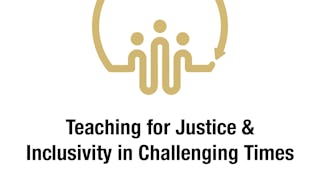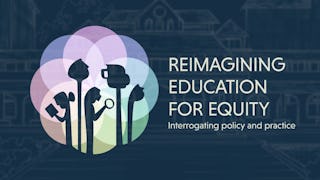The course assumes that higher education is a gateway to the resources of society and that there is a need for institutions to become more socially just for all groups, with emphasis on low-income and minority populations that are traditionally underrepresented.

Gain next-level skills with Coursera Plus for $199 (regularly $399). Save now.

What you'll learn
Understand strategies for strengthening socially-just teaching and learning.
Explore strategies and structures needed for institutional change based on diversity, equity, and inclusion.
Skills you'll gain
Details to know
See how employees at top companies are mastering in-demand skills

There are 8 modules in this course
What is a socially-just university? is a question arising at a time when American society is changing, and challenging many institutions to reconsider some of their most fundamental purposes and practices.
What's included
2 readings1 discussion prompt
American society is changing and, in so doing, challenging higher education to adapt to these changes. As society increases in its people of African, Asian, and Latin American descent, and people of color become the majority, for example, unanswered questions are arising about what universities are for, and who are they for?
What's included
1 video2 readings1 discussion prompt
What is, or should be, the purpose of higher education?
What's included
1 video3 readings1 discussion prompt
Learning and teaching are central to the core educational mission of universities, but what happens to these activities when the institutions are changing in their population?
What's included
1 video2 readings1 discussion prompt
Research and scholarship produce “knowledge for society,” but knowledge development has various approaches.
What's included
1 video2 readings1 discussion prompt
Faculty members are central to higher education, and nothing lasting happens without them. But, what are some ways to engage faculty members, especially at a time when universities are changing in their composition?
What's included
1 video2 readings1 discussion prompt
The University of Michigan is involved in a comprehensive effort to transform the institution for diversity, equity, and inclusion, and this effort requires institutional changes at all levels.
What's included
1 video2 readings1 discussion prompt
This module will give you an opportunity to reflect on what you’ve learned throughout this experience and to contemplate what pieces of the conversation are missing.
What's included
2 readings
Offered by
Explore more from Education
 Status: Preview
Status: PreviewUniversity of Michigan
 Status: Preview
Status: PreviewUniversity of Colorado Boulder
 Status: Free
Status: FreeUniversity of Colorado Boulder
 Status: Preview
Status: PreviewIndian Institute for Human Settlements
Why people choose Coursera for their career





Open new doors with Coursera Plus
Unlimited access to 10,000+ world-class courses, hands-on projects, and job-ready certificate programs - all included in your subscription
Advance your career with an online degree
Earn a degree from world-class universities - 100% online
Join over 3,400 global companies that choose Coursera for Business
Upskill your employees to excel in the digital economy
Frequently asked questions
To access the course materials, assignments and to earn a Certificate, you will need to purchase the Certificate experience when you enroll in a course. You can try a Free Trial instead, or apply for Financial Aid. The course may offer 'Full Course, No Certificate' instead. This option lets you see all course materials, submit required assessments, and get a final grade. This also means that you will not be able to purchase a Certificate experience.
More questions
Financial aid available,



